Sanmar Shipyards Delivers First ABS-classed Battery Electric Tug to HaiSea Marine
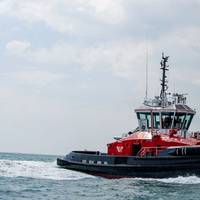
Sanmar Shipyards delivered its first battery electric tug to ABS class for Canada-based HaiSea Marine, a joint venture partnership between the Haisla First Nation and Seaspan ULC.The HAISEA WAMIS harbor tug, the first in its ElectRA 2800SX series, will be part of a fleet of harbor and escort tugs providing services to LNG Canada’s future terminal in British Columbia and is equipped with two steerable, fixed pitch (FP), azimuthing, L-drive propulsion units powered by electric motors integrated on top of each unit.
Power Play: Innovative Mobile Device Connects Vessels to Shoreside Electricity
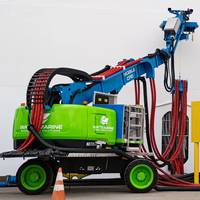
Mobile Cable Positioning Devices can quickly accommodate vessels of many sizes and shapes, making shore power available almost immediately, a boon to the industry’s ambitious decarbonization goalsOne of the keys to reaching Cruise Lines International Association’s (CLIA) target of net-zero carbon cruising globally by 2050 is switching from diesel burning engines to shoreside electricity while in port. Although the technology can significantly reduce emissions to address climate change and improve air quality…
ABS Publishes Guidance on Hybrid Electric Power Systems

Classification society ABS has published new technical guidance on hybrid electric power systems (HEPS) for vessels.Available for download from the company's website, the publication, Practical Considerations for Hybrid Electric Power Systems Onboard Vessels, explores the different forms of HEPS and offers practical insight into their application on board. It explores renewable energy sources, energy storage systems, battery management approaches, the potential for modeling and simulation…
Vallianz to Build All-electric, Zero Emissions Harbor Tug

A new all-electric, zero carbon emissions harbor tug currently being built at the Vallianz PT USP shipyard in Batam, Indonesia is expected to be the first of its kind in the Asia Pacific region.Based on the “E-Volt Electric Tug” design by SeaTech Solutions International Pte Ltd, the e-tug will be driven by a fully-classed electric battery system provided by Canadian-based Shift Clean Energy. This follows a recent memorandum of understanding between Vallianz and Shift to collaborate…
Havyard Delivers Another Offshore Wind Service Vessel to Esvagt

Norway-based Havyard Leirivik said Thursday it had handed over a new wind farm service vessel to the Danish shipowner Esvagt.The vessel named ‘Alba’ is the second in a series of three vessels.Havyard's Norwegian Electric Systems has delivered the bridge solution and automation and electric power systems on board. Norwegian Greentech has provided a system for the treatment of ballast water, while HAV Design has been responsible for the ship design.The wind farm service vessel is…
ABS Publishes Fuel Cell Guidance
ABS published its Guide for Fuel Cell Power Systems for Marine and Offshore Applications to support the design, evaluation, and construction of fuel cell systems on vessels and offshore assets.“As technology evolves and regulators challenge shipping to decarbonize, fuel cells are increasingly seen as having an important role to play in meeting that challenge,” said Gareth Burton, ABS Vice President, Technology. “ABS has in-depth experience in assisting vessel owners and operators in low carbon emission options. Now is the right time to support the industry with guidance on compliant and efficient application of fuel cell power.”The Guide…
Swedish Electric Ferry Gets Superfast Charging
Swedish power company Vattenfall and compatriot electric ferry propulsion systems and marine consultancy platform Echandia Marine cooperate on electric ferry with superfast charging.Vattenfall and Echandia Marine have developed a new solution for electric ferries that is designed to minimise emissions and noise and at the same time lower operational and maintenance costs and provide superfast charging.The systems are installed on E/S Movitz that operates in central Stockholm and can be fully charged within 10 minutes with up to 500 kW charging power.The companies have together developed a new concept that can contribute to a more sustainable…
ABS to Class First 'Tri-fueled' Vessel for Harvey Gulf
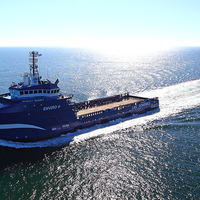
ABS has been selected to class two Offshore Supply Vessels (OSV) being retrofitted with a battery/converter system by Harvey Gulf International Marine.The Harvey Energy will become the first ABS-classed dual fuel and battery vessel and the first U.S. flagged OSV equipped with a battery/converter system. The Harvey Supporter will become the second vessel in the Harvey Gulf fleet to have a battery power system.The battery installation, which is expected to achieve the ABS class notation ESS-LiBATTERY…
Rolls-Royce Receives AIP For Hybrid Tug Propulsion System
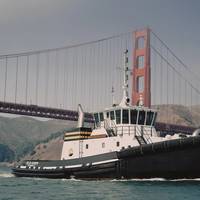
Rolls-Royce received Approval in Principle (AIP) from classification organization ABS for its novel hybrid propulsion system for tractor tugs.The AIP was granted following an evaluation of the world’s first hybrid tug, a unique vessel designed by Jensen Maritime and which Nichols Brothers Boat Builders will deliver to Baydelta Maritime LLC in February 2019. The vessel will be the first tug boat installed with the Rolls-Royce hybrid propulsion system.ABS considers the Rolls-Royce hybrid system is…
ABB, Sintef to Test Hydrogen Fuel Cells
Norwegian Sintef Ocean and ABB Marine will use two 30kW hydrogen fuel cells, set up in laboratory to model the operation and control of a complete marine power system in a megawatt-scale propulsion plant."ABB and Sintef Ocean are undertaking groundbreaking research to test the viability of fuel cells as an energy source for main ship propulsion. The new research project seeks to provide the answers required for fuel cell technology to be delivered at the scale needed to power commercial and passenger ships," said a press release.The testing methodology, to be developed at Sintef Ocean’s Trondheim-based laboratory, will use two 30kW fuel cells…
ABS Grants AIP for Wärtsilä HY Hybrid Power Module
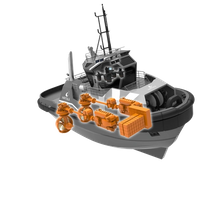
Wärtsilä’s hybrid power module, the Wärtsilä HY, has been granted Approval in Principle (AIP) by ABS. This AIP follows another issued by ABS in 2017 for Wärtsilä’s hybrid propulsion tug designs.Wärtsilä said it leveraged its strengths in both engine design and electrical and automation (E&A) systems do develop the fully integrated hybrid power module combining engines, an energy storage system and power electronics optimized to work together through a newly developed energy management system (EMS).
Tech File: Propelling Hybrid Electric Solutions
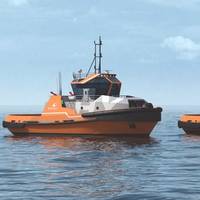
Growing interest in hybrid-electric power systems is expanding the search for new propulsion and energy-storage systems in the workboat sector, where compliance with emerging environmental regulations and a relentless pursuit of operational efficiency are driving change. To meet demands for cleaner more efficient power, owners are examining the potential for less conventional methods of energy generation and storage – such as fuel cells, lithium-ion batteries, super-capacitors, flywheels, wind and solar – to propel their vessels.
ABS: New Guidance on Energy Storage
ABS has published The ABS Guide for Use of Supercapacitors in the Marine and Offshore Industries (Supercapacitor Guide) to support safe application of hybrid power in the marine and offshore industries. The maritime industry is increasingly interested in using supercapacitors as an energy storage solution when quick energy delivery is required during a peak loading condition. Particularly, offshore supply vessel (OSV) owners are considering supercapacitors to supplement energy supply during high-load operations, such as using power thrusters for dynamic positioning while station keeping. "We are developing a series of guides on energy storage systems so our clients have as many options as possible to effectively manage energy use…
ABS Advises on Hybrid Electric Power Systems

ABS has published the ABS Advisory on Hybrid Electric Power Systems to help marine and offshore owners and operators make decisions about energy generation and storage. “ABS continues to lead industry safety with the first comprehensive Advisory to address the latest hybrid electric power technologies,” said ABS Chairman, President and CEO Christopher J. Wiernicki. With the increased industry focus on environmental compliance and operational performance, many owners and operators…
Shock Test Machine Saves Navy Big Bucks
The Navy's new Deck Simulator Shock Machine (DSSM) improves shipboard electronics reliability while reducing testing costs as equipment evaluations began in Philadelphia, saving the Navy $75,000 per test, as it meassures the effects of simulated underwater explosions on electronic equipment, informs Naval Sea Systems Command. The mammoth machine evaluates state-of-the-art, vibration-sensitive electronics cabinets weighing up to 1,500 pounds on shock isolation mounts. One of two such machines worldwide, the mechanism sits on 22,000 pounds of steel and concrete and records the effects of simulated underwater explosions on electronics equipment.
Installation of Dry Flexible Coupling on USS Essex (LHD 2)
Engineers at the Naval Ship Systems Engineering Station (NAVSSES), Naval Surface Warfare Center Carderock Division in Philadelphia recently oversaw the installation of dry flexible couplings on the lube oil service pumps and main feed pumps on USS Essex (LHD 2). The new couplings replace grease-lubricated versions eliminating hazardous waste and quarterly maintenance requirements for Sailors. The new couplings will run for a year on Essex before moving forward with installation on other amphibious ships. "The dry flex coupling, a device used to connect two moving parts of a system, replaced grid couplings that required more than three pounds of grease to keep each of the eight on board lubricated, " said Brett Franks, mechanical engineer and machinery alteration program manager.
Maran Takes Delivery of Electric LNG Carrier
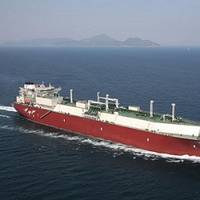
The first electrical LNG carrier to be ordered by Maran Gas incorporating induction-based electric propulsion motor technology from GE’s Power Conversion business is expected to enter commercial service in July. The Woodside Rogers, built by one of the major Korean shipbuilders, Daewoo Shipbuilding & Marine Engineering (DSME), at its shipyard near Busan, successfully completed sea trials in late April and was handed over to Maran Gas on July 1. It is the first of seven LNG carriers…
Control Systems on LCC 20 Saves Fuel, Reduces Workload
Naval Sea Systems Command completed the installation of new control systems aboard USS Mount Whitney (LCC 20), April 8, which will reduce fuel usage and crew workload. Engineers from the Naval Surface Warfare Center Carderock Division - Ship Systems Engineering Station (NSWCCD-SSES) SSES installed the new control systems on a number of shipboard engineering components and are specifically designed to improve automation on the optimally manned ships. “Military Sealift Command-operated ships like the Mount Whitney traditionally have lower manning levels, therefore being able to operate many systems from one central control unit is essential,” said Matthew Douglass, Auxiliary Machinery Automation Branch head.
Dead in the Water
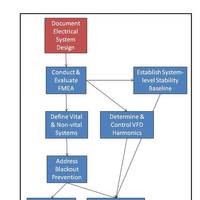
The world watched as the Carnival Triumph sat still, dead in the water in the Gulf of Mexico after a main space fire caused a total loss of electrical power. For the 3,143 passengers and 1,000-plus crewmembers, there was no heat or air conditioning, toilets or sanitation, lights or ventilation. Fortunately, despite the seriousness of the fire, which was caused by a leaking fuel line, nobody was hurt. We waited and watched for several days for tugs to arrive on the scene and begin the slow process of pulling the 893-foot ship to port to let her passengers debark and commence repairs.
Fastener Commonality Deep Dive Yields Navy Supply System Efficiencies
Naval Sea Systems Command completed a fleet-wide fastener study, identifying and recommending the removal of thousands of fasteners from the Navy supply system. The 16-week supply system review identified 108,000 dormant fasteners-fasteners with no contract, requisition or maintenance history in the past five years-and 3,200 duplicate fasteners where two or more identical fasteners had different stock numbers. The NAVSEA Commonality Project management team led the study, collaborating with in-service engineering agents, technical warrant holders, program offices, shipyards, shipbuilders, the Defense Logistics Agency and original equipment manufacturers.
New Control Systems Installed on USS Mount Whitney
Naval Sea Systems Command completed the installation of new control systems aboard USS Mount Whitney (LCC 20), April 8, which will reduce fuel usage and crew workload. Engineers from the Naval Surface Warfare Center Carderock Division - Ship Systems Engineering Station SSES installed the new control systems on a number of shipboard engineering components and are specifically designed to improve automation on the optimally manned ships. "Military Sealift Command-operated ships like the Mount Whitney traditionally have lower manning levels, therefore being able to operate many systems from one central control unit is essential," said Matthew Douglass, Auxiliary Machinery Automation Branch head.
MetalCraft Unveils First Electric Powered Patrol Boat
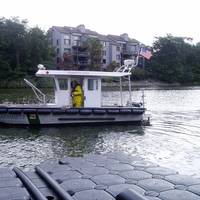
Patrol Boat-1 is really the first, the first ever electric powered patrol boat. MetalCraft Marine designed and built the boat for the City of Annapolis’ Harbormaster. The boat utilizes a Steyr hybrid diesel/electric engine that permits either electric power or for higher speeds, diesel power. The propulsion is a Hamilton 274 waterjet. The jet can propel the boat in electric patrol mode at 4.5 knots, as it approaches and checks boats in the harbor ensuring anchoring permits are valid.
MetalCraft Unveils First Electric Powered Patrol Boat
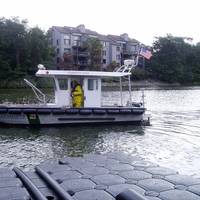
Patrol Boat-1 is really the first, the first ever electric powered patrol boat. MetalCraft Marine designed and built the boat for the City of Annapolis’ Harbormaster. The boat utilizes a Steyr hybrid diesel/electric engine that permits either electric power or for higher speeds, diesel power. The propulsor is a Hamilton 274 waterjet. The jet can propel the boat in electric patrol mode at 4.5 knots, as it approaches and checks boats in the harbor ensuring anchoring permits are valid.









